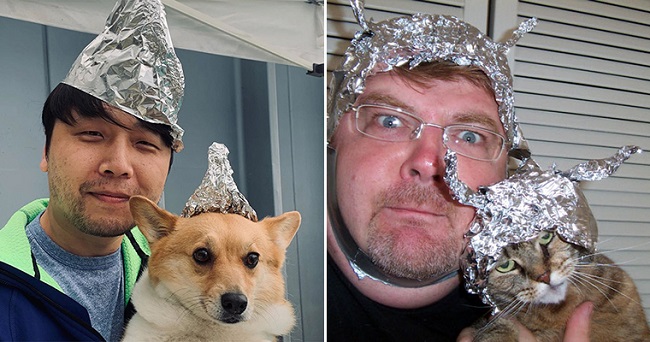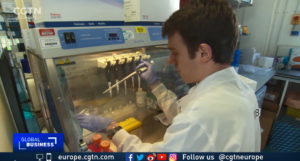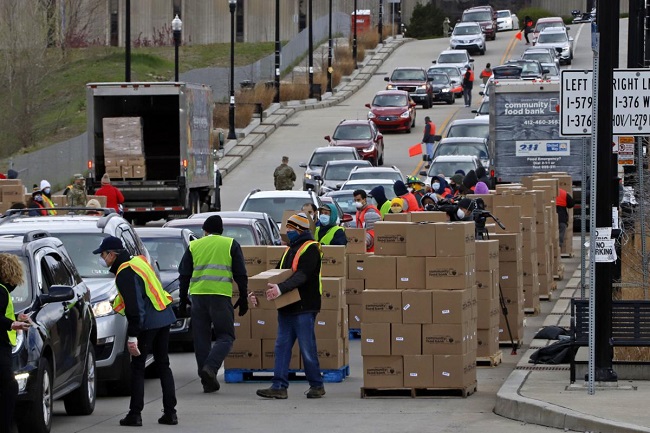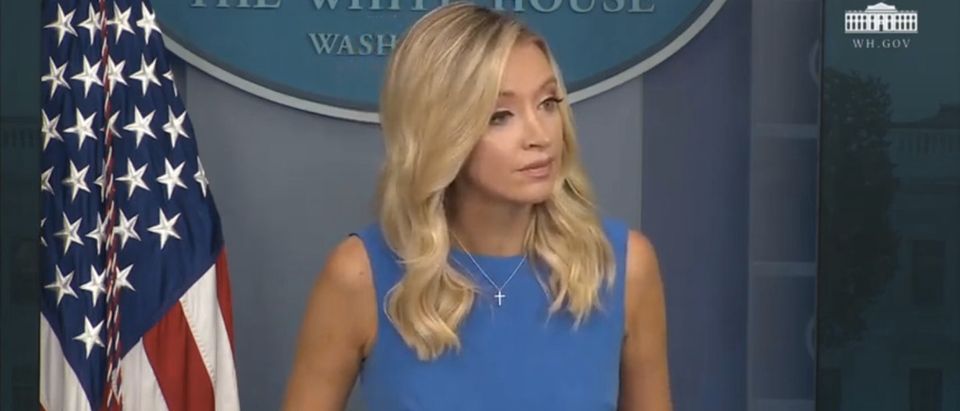The Coronavirus Is Not A Conspiracy Theory

But there is a conspiracy. Your President is conspiring to get you killed and make you a slave. And that’s one conspiracy that you better pay attention to.

But there is a conspiracy. Your President is conspiring to get you killed and make you a slave. And that’s one conspiracy that you better pay attention to.
WASHINGTON (Reuters) – U.S. employment growth slowed considerably in July amid a resurgence in new COVID-19 infections, offering the clearest evidence yet that the economy’s recovery from the recession caused by the pandemic was faltering. Nonfarm payrolls increased by 1.763 million jobs last month after a record 4.791 million in June, the Labor Department said on Friday. Economists polled by Reuters had forecast 1.6 million jobs were added in July. The unemployment rate fell to 10.2% from 11.1% in June, but it has been biased downward by people misclassifying themselves as being “employed but absent from work.” At least 31.3 million people were receiving unemployment checks in mid-July.
“The steam has gone out of the engine and the economy is beginning to slow,” said Sung Won Sohn, a finance and economics professor at Loyola Marymount University in Los Angeles. “The loss of momentum will continue and my concern is that the combination of the virus resurgence and lack of action by Congress could really push employment into negative territory.”
The labor market step-back is more bad news for President Donald Trump, who is lagging in opinion polls behind former Vice President Joe Biden, the presumptive Democratic Party nominee for the Nov. 3 election. It also piles up pressure on the White House and Congress to speed up negotiations on a second aid package, which have been dragging over differences on major issues including the size of a government benefit for tens of millions of unemployed workers. A $600 weekly unemployment benefit supplement expired last Friday, while thousands of businesses have burned through loans offered by the government to help with wages. The economy, which entered into recession in February, suffered its biggest blow since the Great Depression in the second quarter, with gross domestic product dropping at its steepest pace in at least 73 years. Infections of the respiratory illness soared across the country last month, forcing authorities in some of the worst affected areas in the West and South to either shut down businesses again or pause reopenings, sending workers back home. Demand for goods and services has suffered. The slowdown in hiring challenges the U.S. stock market’s expectation of a V-shaped recovery. The S&P 500 index .SPX is up nearly 50% from its March trough. As COVID-19 cases spiral, and Republicans and Democrats bicker over another stimulus package, economists see a W-shaped recovery. Economists estimate the Paycheck Protection Program that gave businesses loans that can be partially forgiven if used for employee pay saved around 1.3 million jobs at its peak. The extra $600 weekly unemployment checks made up 20% of personal income and helped to boost consumer spending in May and June.
https://youtu.be/O3b3LtPt4N8
The United States has recorded more than 2,000 coronavirus deaths in 24 hours, the highest number of daily fatalities in three months, Johns Hopkins University’s real-time tally showed Thursday.
The country, which has seen a major resurgence in coronavirus since the end of June, added 2,060 deaths in one day as well as more than 58,000 new cases, the Baltimore-based university showed at 8:30 pm (0030 GMT Friday).
The last time the US recorded more than 2,000 deaths in 24 hours was on May 7.

President Trump says he’s “optimistic” that a vaccine will be ready around Election Day, and it “wouldn’t hurt” his chances against former Vice President Joe Biden. But having a vaccine available for widespread public use before 2021 is unrealistic, according to public health experts, including the Coronavirus Task Force’s Dr. Anthony Fauci. Mr. Trump told Geraldo Rivera’s radio program “Geraldo in Cleveland,” on WTAM, Thursday that a vaccine could “in some cases” be ready sooner than November 3, but “right around that time.” Asked about this on the White House South Lawn a couple hours later, the president said he’s “optimistic” about a vaccine being ready around that date. “I’m optimistic that it’ll be probably around that date. I believe we’ll have the vaccine before the end of the year, certainly, but around that date, yes, I think so,” Mr. Trump sad.

Your world, my world, our world will never be the same again. The sooner you accept and understand these profound changes, the better off you’ll be. Everyone around you is eagerly awaiting life to return to normal. There is no normal, there is no new normal, you’ve entered the twilight zone of abnormal.
(Bloomberg) — Investors should consider the risk of a successful coronavirus vaccine unsettling markets by sparking a sell-off in bonds and rotation out of technology into cyclical stocks, according to Goldman Sachs Group Inc.
The increased probability of an approved vaccine by the end of November is underpriced by equity markets, wrote strategists including Kamakshya Trivedi in a note Wednesday. Over the next few months, the ramifications of the U.S. election and the evolution of the virus — in part as schools reopen — are also likely to be key drivers of the market, they said.
Approval of a vaccine could “challenge market assumptions both about cyclicality and about eternally negative real rates,” the team wrote, adding such a scenario may support steeper yield curves, traditional cyclicals and banks, while challenging the leadership of technology stocks. If this happened along with a change in the U.S. administration, emerging market equities could benefit “if trade policy risks diminish while U.S. tax risks rise,” according to the note.
They see a potential downside target of 2,200 in the S&P500 should there be a significant reversal of activity from a second wave of the virus, the strategists added. The U.S. benchmark closed just under 3,328 on Wednesday.
As the race for a COVID-19 vaccine heads into the stretch run, scientists are tempering their enthusiasm with caution. The biotechnology company Moderna and the National Institutes of Health have begun Phase III efficacy trials for their vaccine. The University of Oxford and Pfizer are running combined Phase II and III testing for their respective drugs. All together, drugmakers have 27 vaccines in trials. The goal of Operation Warp Speed, the U.S. vaccine initiative, is 300 million doses of a safe, effective vaccine by January, and if realized, it would be one of the greatest scientific achievements of all time. On Tuesday, Goldman Sach predicted the Food and Drug Administration would approve at least one vaccine before the end of the year. Dr. Anthony Fauci, director of the National Institute of Allergy and Infectious Diseases, said last month he was hopeful a vaccine would be available by late fall or early winter.
Here’s what worries scientists:
—FDA regulators will likely face enormous political pressure to approve a vaccine, even one that’s not proven safe and effective.
—A vaccine that’s less effective than billed could cause wider spread of the pandemic, Michael S. Kinch, director of the Centers for Research Innovation in Biotechnology and Drug Discovery at Washington University in St. Louis, writes in Stat News.
“A merely short-term effect could encourage vaccinated individuals to resume risky behaviors, which would all but guarantee that the epidemic endures,” argues Kinch, who is also a professor of biochemistry and molecular biophysics.
—A vaccine would likely erode compliance of social distancing and mask wearing, measures that are proven effective against spread of the virus.
“They automatically are going to say, ‘Oh great, I’m just going to get my little vaccine, and I can go back and do exactly the things I was doing last year’. That is absolutely not true,” Maria Elena Bottazzi, associate dean of the National School of Tropical Medicine at Baylor College of Medicine, told Business Insider in an interview.
—We don’t have enough data.
“What we have right now is a collection of animal data, immune response data and safety data based on early trials and from similar vaccines for other diseases,” writes Natalie Dean, assistant professor of biostatistics at the University of Florida, in the New York Times.
“The evidence that would convince me to get a COVID-19 vaccine, or to recommend that my loved ones get vaccinated, does not yet exist,” she says.
—If a substandard vaccine is green-lighted without adequate testing or trials, unforeseen harmful side effects could emerge. A weak initial vaccine and/or one with dangerous side effects would likely cause confidence in all vaccines to plummet and strengthen anti-vaccine sentiments. If a safer, more effective vaccine were subsequently developed, the residual mistrust could result in fewer people getting vaccinated.
—Epidemiologists estimate that to tame the pandemic, at least 70 percent of the population may need to develop immunity, either by vaccine or getting infected. Millions of Americans refusing to get inoculated by a vaccine that’s at least 50 percent effective (the minimum level according to the World Health Organization) could thwart that goal.
—A vaccine might only provide short-term immunity because of the nature of coronaviruses. Back in April, Dr. David States, professor of human genetics and director of bioinformatics at the University of Michigan, tweeted:
“If you’re hoping a vaccine is going to be a knight in shining armor saving the day, you may be in for a disappointment. SARS COV2 is a highly contagious virus. A vaccine will need to induce durable high level immunity, but coronaviruses often don’t induce that kind of immunity.”

(Screenshot/YouTube/White House)
President Donald Trump is not considering a national lockdown to stop the spread of coronavirus, White House Press Secretary Kayleigh McEnany confirmed Tuesday. Trump and Republicans have long pushed back on the idea of a mandatory national quarantine, citing the federal government’s lack of authority to do so under the Constitution. Trump called on state governors to institute distancing measures tailored to their own states this spring, resulting in widespread protests against governors who took a more severe route.
“The president is not considering a national lockdown,” says Kayleigh McEnany.
— Chris Megerian (@ChrisMegerian) August 4, 2020
Some experts say the lifting of current distancing measures across the country relies largely on the production of a successful coronavirus vaccine. White House Coronavirus Task Force member Dr. Anthony Fauci has said he is optimistic that a vaccine will be developed before 2021. The Trump administration’s ‘Operation Warp Speed’ project is aimed at partnering the public and private sectors to develop a vaccine or therapeutics to combat COVID-19.
Dr. Amesh Adalja of the Johns Hopkins University Center for Health Security told the Daily Caller it may be more than a year before life returns to what Americans thought of as normal in 2019, however.
Adalja said the development of a vaccine is one part of the solution, but that vaccine must then be mass-produced, a process which he says could take until 2022.